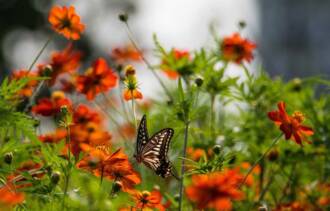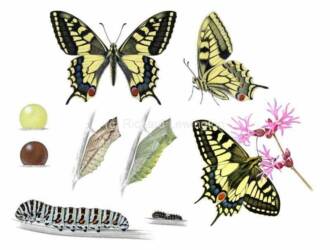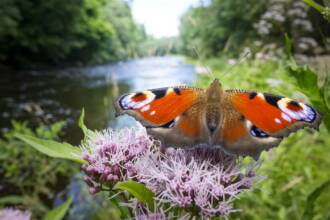
Butterflies are arthropods that are among the most beautiful creatures of nature. These delicate and graceful creatures attract attention with their bright colors and delicate wings. Butterflies delight with their beauty and uniqueness, their diversity amazes the imagination.
Butterfly wings are a true work of art. They come in a variety of patterns, colors and textures. Each butterfly species has its own unique wings, which serve to attract attention and protect against predators. The magnificent colors and patterns on the wings of butterflies make them truly magnificent and beautiful.
Butterflies play an important role in the ecosystem. They are pollinators for many plants, helping them reproduce. Thanks to their active sex life and attractiveness to other individuals of their species, butterflies contribute to the preservation and increase of the population. They also serve as food for various predators, which helps maintain balance in nature.
Diversity of butterflies in nature

Butterflies are one of the most beautiful groups of insects. They belong to the class of arthropods and have unique features. There is a huge variety of butterfly species in the world, which differ in size, color and lifestyle.
One of the most famous and beautiful groups of butterflies are tropical butterflies. They live in tropical forests and are distinguished by their bright colors and large sizes. Tropical butterflies can have a wide variety of colors and patterns on their wings, making them truly impressive.
Some species of butterflies are well camouflaged and are able to hide on leaves or in grass. This helps them avoid predators and remain undetected. Other species of butterflies, on the contrary, are brightly colored and serve as a signal to potential enemies - they warn of their poisonousness or unpleasant taste.
How does butterfly metamorphosis occur?
Butterflies are arthropods that undergo an amazing process of metamorphosis. During their life, butterflies go through four stages of development: egg, caterpillar, pupa, and adult.
It all starts with an egg that a butterfly lays on plants. The egg hatches into a caterpillar that actively feeds on leaves and grows. The caterpillar has special jaws with which it chews off pieces of food. At this stage, it constantly grows and changes its skin several times.
Once the caterpillar reaches a certain size, it turns into a pupa. The caterpillar attaches itself to a branch or other suitable surface and forms a protective shell in the form of a cocoon or scales. Amazing transformations take place inside the pupa: the body of the caterpillar decomposes, and from this chaos a new body of the butterfly begins to form.
After several weeks, when the metamorphosis is complete, the pupa emerges into an adult butterfly. At this stage, she has completely transformed: she has wings, and her organs and systems begin to function. The butterfly is ready for its new life, it can fly, look for food and reproduce.
The role of butterflies in the ecosystem

Butterflies are arthropods that play an important role in the ecosystem. They are important pollinators of plants, helping them reproduce and maintain species. Most butterflies feed on flower nectar, and when they visit a flower, they transfer pollen from one flower to another, helping pollination.
Butterflies also provide food for many other animals. Chicks, frogs, lizards and other animals feed on butterflies and their caterpillars. This creates food chains and maintains biodiversity in the ecosystem.
Some species of butterflies also play an important role in the decomposition of organic matter. Their caterpillars feed on leaves and can help dispose of plant debris and organic waste.
In addition, butterflies are indicators of the state of the environment. Changes in butterfly abundance and species diversity may indicate changes in the ecosystem, such as air pollution, destruction of natural habitats, or the use of pesticides.
Features of the structure of butterfly wings
Butterflies, like other arthropods, have a paired wing-shaped body compartment, which consists of two wings. Butterfly wings are one of the most notable and unique anatomical features of this class of insects.
Butterfly wings have incredible beauty and a variety of shapes and colors. They can be painted in bright and rich colors, and also decorated with various patterns and designs. Such a varied wing design allows butterflies to be unique and recognizable.
Butterfly wings are thin membranes that are supported and strengthened by special veins. These veins, running across the entire surface of the wings, provide them with strength and stability. Thanks to this, butterflies can fly and move through the air with great ease and maneuverability.
Butterfly wings also have numerous microscopic scales that cover their surface. These scales give butterfly wings a special shine and reflect light, creating the effect of flickering and iridescent colors. Thanks to these scales, butterfly wings become even brighter and more attractive to the opposite sex and protect them from external influences.
Methods of butterfly communication
Butterflies are arthropods that have the ability to communicate using various signals and movements.
1. Visual signals. Butterflies use their bright colors and wing patterns to communicate. These patterns can serve as signals to other butterflies to indicate their readiness to breed or to ward off predators.
2. Chemical signals. Butterflies can secrete pheromones, chemicals that serve to attract a mate. These scents can be very unique to each butterfly species and help them find suitable companions.
3. Sound signals. Some butterflies, especially those found in tropical forests, may make sounds to attract the attention of a mate or to scare off a predator. These sounds are created by rubbing the wings or other parts of the butterfly's body.
4. Tactile signals. Butterflies can use their delicate feet to send signals to each other. They may touch other butterflies to show their desire to hover or compete.
5. Posture and movements. Butterflies can adopt certain postures and move in specific ways to convey certain signals. For example, they can spread their wings to show their superiority or, conversely, humility in front of another butterfly.
Distribution of butterflies around the world

Butterflies are beautiful and delicate arthropods that live in almost every corner of our planet. They are one of the most numerous groups of insects, and their diversity is amazing.
Butterflies are found in a variety of places, from hot tropical forests to cold mountain plateaus. They live on all continents, with the exception of Antarctica. Among butterflies you can find representatives of a wide variety of species and families, each of which has its own characteristics and adaptations.
Some butterflies prefer to live in forested areas, where they can find protection from predators and an abundance of food. Others prefer open fields and meadows where they can find flowers and nectar to feed on. Some butterfly species migrate long distances, moving from one habitat to another in search of food and breeding conditions.
Butterflies are truly amazing creatures that adorn our planet with their beauty and grace. Their distribution around the world shows that they have successfully adapted to various habitat conditions and continue to delight us with their presence.
Why are butterflies so attractive to people?
Butterflies are arthropods that attract people's attention and interest with their bright colors and intricate patterns on their wings. Their beauty and grace are admired and inspire many artists and poets.
One of the reasons butterflies are so attractive is their metamorphosis. From egg to full-fledged adult insect, there are several stages of development, including caterpillar and pupa. This process of transformation evokes wonder and interest among people, as it symbolizes change, transformation and rebirth.
Butterflies are also associated with lightness and freedom. Their smooth and graceful flights create a feeling of ease and beauty. Butterflies are often depicted in various works of art, symbolizing beauty, elegance and freedom of spirit.
In addition, butterflies are important plant pollinators. They transfer pollen from one flower to another, promoting plant reproduction. Without their participation, many plant species would not be able to reproduce and exist. This ecological aspect makes butterflies even more attractive to people, as they play an important role in maintaining biodiversity on the planet.
Butterflies in culture and art

Butterflies are not only beautiful arthropods of nature, but also objects of inspiration for many artists and poets. In culture and art, they symbolize lightness, transformation and beauty.
Artists often depict butterflies in their paintings, using bright and varied colors to convey their grace and delicacy. Butterflies are also a popular motif in Japanese art paintings, where they symbolize beauty and ephemerality.
Poets often use images of butterflies in their poems to convey lightness and freedom. Butterflies are often associated with spring and summer, with their bright colors and easy flight. They can also serve as a symbol of change and transformation.
IN folk legends And fairy tales You can find many stories about butterflies that transform from caterpillars into beautiful insects. These stories convey the idea of the possibility of transformation and the transition from one state to another.
IN fashion and design Butterfly motifs can also be found. They decorate clothes, accessories and jewelry, giving them sophistication and lightness. Butterflies are also used as patterns on fabrics and wallpaper to create an atmosphere of beauty and harmony.
In general, butterflies play an important role in culture and art, inspiring artists, poets and designers with their unique beauty and symbolic meaning.
Threats and protection of butterflies in the modern world
Butterflies, like other arthropods, face various threats in the modern world. One of the main problems is the loss of natural habitats due to the destruction of natural environments, including deforestation and land development. This results in fewer areas where butterflies can live and fewer food resources for the caterpillars.
The second major threat is environmental pollution, including the use of pesticides and herbicides. These chemicals can negatively affect butterflies by destroying their natural food plant or causing problems with their reproduction and development.
Additionally, climate change is also having a major impact on butterflies. Changes in temperature, precipitation and seasonality can lead to shifts in their range and disruption of life cycles. For example, butterflies that rely on certain conditions to reproduce or feed may be faced with a lack of needed resources in their new environment.
Butterfly conservation requires action at global and local levels. This may include the creation of nature reserves and protected areas to preserve natural habitats. It is also important to limit the use of chemicals, especially near butterfly habitats. Additional measures may include encouraging the use of environmentally friendly farming and gardening practices.
Butterfly conservation is an important aspect of conserving biodiversity and the ecosystem as a whole. Butterflies play an important ecological role by pollinating flowers and serving as food for other animals. Therefore, preserving their numbers and diversity is a task that requires joint efforts and attention from society.






